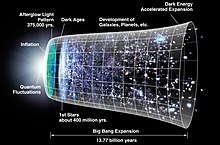Initial singularity
The initial singularity is a singularity predicted by some models of the Big Bang theory to have existed before the Big Bang.[1] The instant immediately following the initial singularity is part of the Planck epoch, the earliest period of time in the history of our universe.
Traditional models of our universe[edit]

The use of only general relativity to predict what happened in the beginnings of the universe has been heavily criticized, as quantum mechanics becomes a significant factor in the high-energy environment of the earliest universe, and general relativity on its own fails to make accurate predictions.[1][2] In response to the inaccuracy of considering only general relativity, as in the traditional model of the Big Bang, alternative theoretical formulations for the beginning of the universe have been proposed, including a string theory-based model in which two branes, enormous membranes much larger than the universe, collided, creating mass and energy.[3]
Although there is no direct evidence for a singularity of infinite density, the cosmic microwave background is evidence that the universe expanded from a very hot, dense state.[4]
Alternatives to the singularity[edit]
Various new models of what preceded and caused the Big Bang have been proposed as a result of the problems created by quantum mechanics. One model, using loop quantum gravity, aims to explain the beginnings of the universe through a series of Big Bounces, in which quantum fluctuations cause the universe to expand. This use of loop quantum gravity also predicts a cyclic model of universes, with a new universe being created after an old one is destroyed, each with different physical constants.[2] These proposals have been criticized as inconsistent with the Borde-Guth-Vilenkin theorem, however their modifications with only one bounce (as opposed to cyclic series of bounces) circumvent this problem (particularly if the contracting phase is empty, i.e. compactified Milne, and (2+1)-dimensional, due to the inherent stabilizing rigidity of vacuum in this case).
Another possibility based on M-theory and observations of the cosmic microwave background (CMB) states that the universe is but one of many in a multiverse, and has budded off from another universe (e.g., one that macroscopically looks like static empty space) as a result of quantum fluctuations such as quantum foam, as opposed to our universe being all that exists.[5]
In some other proposals a quantum-gravitational era is avoided as well.[6]
References[edit]
- ^ a b Wall, Mike (21 October 2011). "The Big Bang: What Really Happened at Our Universe's Birth?". The History & Future of the Cosmos. Space.com. Retrieved April 16, 2012.
- ^ a b Penn State (2 July 2007). "What Happened Before The Big Bang?". ScienceDaily. Retrieved April 16, 2012.
- ^ Lamb, Robert (12 May 2010). "Branes, Crunches, and Other Big Ideas". What existed before the big bang?. HowStuffWorks. Retrieved April 16, 2012.
- ^ "What If the Big Bang Wasn't the Beginning? New Study Proposes Alternative". Space.com. 5 December 2017. Retrieved 2 April 2018.
- ^ Atkinson, Nancy (13 June 2008). "Thinking About Time Before the Big Bang". Universe Today. Universe Today. Retrieved April 16, 2012.
- ^ https://arxiv.org/abs/2310.02338
